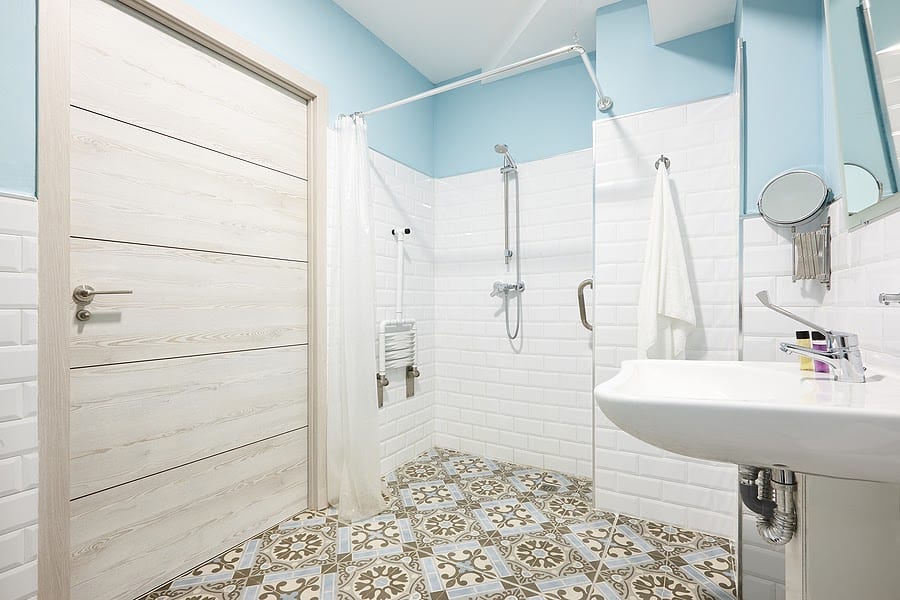If you or someone you live with requires a home that is compliant with the Americans with Disability Act (ADA), it can be difficult to figure out exactly where to start. This is especially true of important areas like the bathroom, which can require some degree of specialized equipment in order to ensure the highest possible standard of living.
The ultimate goal in accessible design is to make the bathroom space safe and comfortable for everyone who uses it. It is important to carefully plan the building or remodeling of an accessible bathroom by taking inventory of the users capabilities and preferences, but if wondering where to start, Schuler Service is here to help.
Without further ado, here are five things to consider when designing a handicap accessible bathroom.
General Access and Safety
A handicap accessible bathroom should be large and spacious enough to accommodate mobility devices, and the all doorways, storage compartments, and countertops should be widened and lowered as well. All bath mats should be removed from the floor in order to prevent mobility issues.
For proper wheelchair access, it is recommended that the space in front of any and all plumbing fixtures be at least 30” x 48” in order to provide room for turnaround and attendants if necessary. It’s also recommended that bathroom doors measure at least 34 inches wide and are designed to open outward. Furthermore, you should opt for lever style door handles as well, as they are typically easier to operate than a doorknob.
There are also many lifts to look into that provide transfers in the bathroom such as hydraulic chair lifts, sling-type lifts, rolling transfer benches, drop in tubs, and more. Be sure to choose fixtures and fittings that are comfortable, convenient, and easy to control with single hand motions, closed fists, or even motion control censored fixtures if possible.
Quality Lighting
Good lighting is essential for bathroom safety, especially in a handicap accessible bathroom. Plan your lighting in a way that creates an even spread of light without any major shadows, and be sure to use natural light as much as possible.
In addition, you should install your light switches at lower positions on the wall to ensure that someone in a wheelchair can access them easily. Install switches that are controlled via large toggles or push buttons rather than something requiring a pinching motion. For those that have difficulty reaching light switches altogether, motion-activated lighting can be especially helpful.
Toilet Accessibility
As one of the main features of any bathroom, an ADA compliant toilet should be between 17 and 19 inches high, the most comfortable height for most users. However, a toilet seat that is higher up will make it easier to lower, stand, or transfer from a wheelchair or walker to the toilet. Thicker toilet seats can be used to add height to a toilet in the event that replacing the toilet is not an option.
In addition, you should carefully consider the placement of necessities such as the toilet paper dispenser, medical equipment, wipes, and other sanitary products. Installing a bidet might be an option for those who find traditional toilet paper use difficult.
Last but certainly not least, installing at least one grab bar to one side of the toilet at the distance of 18 inches to the nearest wall or fixture is recommended; however, the ideal toilet placement is positioned between two support bars that are 36 inches apart.
Sink and Vanity Accessibility
Another important bathroom fixture, the sink should be mounted to the wall with no cabinet underneath. This way, both standing and seated users can easily access it without issue. A maximum rim height of 34 inches with a 27-inch clearance on either side is recommended to provide maximum knee space.
Furthermore, installing single-hand faucets can make it easier to operate and adjust sink water preferences without having to grab or twist. Of course, sensor-based hands-free faucets are also an option.
For vanities, lower placed, extra-long, or tilt mirrors that everyone can use are ideal. Storage of certain toiletry items like dental hygiene products, prescription medications, eye-care products, first-aid supplies, hair styling equipment, makeup, linens, and bath cleaning supplies should be placed in a way that makes them easy to access without compromising mobility. Installing low drawers that pull out is one of the best ways to provide accessible storage solutions.
Shower and Tub Accessibility
Shower and tub accessibility is likely the most challenging aspect of designing an ADA compliant bathroom, but luckily, there are many options and solutions available that can be customized for any level of need.
A rolling or fixed shower seat with a height between 17 and 19 inches can accommodate some users, while a small stool or plastic chair can allow the bather to sit while showering and can be easily removed for those that don’t require it.
For people using a wheelchair or walker, a curbless shower is ideal. These types of showers are designed to feature an opening that is level with the floor and is sloped toward the drain. According to ADA regulations, the shower should be at least 36 inches wide for someone using a transfer seat, and 60 inches wide for someone in a wheelchair.
Be sure to install grab bars in all bathing areas to reduce the risk of slipping or falling. For a tub, two bars should be installed on the sidewall at both standing and sitting range. For a shower, all three walls should have grab bars. It is also important to coordinate the controls near these grab bars whenever possible.
A nonslip floor, overhead lighting, and a handheld showerhead with at least a 60-inch hose are all essential parts of a proper handicap accessible shower as well.
For additional tips on the best way to renovate your home bathroom for handicap accessibility, don’t hesitate to contact the pros at Schuler Service today. No matter what your questions or concerns may be, our experienced team will be ready and willing to assist at a moment’s notice.









